History of Galveston, Texas
The History of Galveston, Texas, begins with the archaeological record of Native Americans who used the island. The first European settlements on the island were constructed around 1816. The Port of Galveston was established in 1825 by the Congress of Mexico following its successful revolution from Spain. The city served as the main port for the Texas Navy during the Texas Revolution. Galveston was founded in 1836 by Matthew Sabo and served as the capital of the Republic of Texas. The Battle of Galveston was fought in Galveston Bay during the American Civil War when Confederate forces under Major General John B. Magruder attacked and expelled occupying Union troops from the city.
.jpg)
During the mid-19th century, Galveston emerged as an international city with immigration and trade from around the U.S. and the world. The city became one of the nation's busiest ports and the world's leading port for cotton exports. Galveston became Texas' largest city and, during that era, was its prime commercial center. In 1900, the island was struck by a devastating hurricane. Even post-Hurricane Katrina, this event holds the record as the United States' deadliest natural disaster.
During the 1920s and 1930s, the city re-emerged as a major tourist destination centered on casinos and other vice businesses. Featuring venues, such as the famed Balinese Room, the city became nationally known as the sin city of the Gulf. The illegal businesses were finally closed in the 1950s, leading to a long, stagnant economic period. Many businesses relocated off of the island, though some, such as the insurance businesses and the medical school, remained.
The city gradually re-emerged as a tourist destination centered on its history and its historical buildings. New tourist attractions were established and further development of the medical school and other area businesses have revitalized the economy in recent decades.
Exploration and settlement

Galveston Island was originally inhabited by members of the Karankawa and Akokisa tribes who used the name "Auia" for the island. In 1519, the Alonso Álvarez de Pineda expedition sailed past Galveston Island en route from the Florida peninsula to the Pánuco River. Pineda may or may not have actually seen the island, however, Spain lay claim to the entire Gulf Coast, including Galveston Island, based on the 1519 Pineda expedition.[1] Soon afterward, Cabeza de Vaca and his crew were shipwrecked on the island (or nearby) in November 1528,[2] calling it "Isla de Malhado" ("Isle of Doom"), and from there began his famous trek to Mexico.[3] Various Spanish explorers charting the region referred to the island as "Isla Blanca" ("White Island") and later "Isla de Aranjuez" ("Aranjuez Island").[4] In 1685 French explorer La Salle named the island "San Louis" ("Saint Louis") and the name became fixed for some time.[4]
The earliest known map of the island and the bay was made by French explorer Bénard de La Harpe in 1721, who left the island unnamed but named the bay "Port François."[3] In 1785, Spanish explorer José de Evia, during his own charting of the Gulf Coast, referred to the island as "San Luis" and the bay as "Bahía de Galveztowm" [sic] ("Galveztowm Bay"), in honor of Bernardo de Gálvez y Madrid, Count of Gálvez.[3] The name San Luis for the island continued to be used by the Spanish and the Mexicans (and later even by Stephen F. Austin's colony),[3][5] and is still used as the name for the pass at the west end of the island.
The first permanent European settlements on the island were constructed around 1816 by the pirate Louis-Michel Aury as a base of operations to support Mexico's rebellion against Spain.[6] In 1817, Aury returned from an unsuccessful raid against Spain to find the island occupied by the pirate Jean Lafitte, who took up residence there after having been driven from his stronghold in Barataria Bay off the coast of New Orleans, Louisiana.[6] Lafitte organized the island's settlement into a pirate "kingdom" he called "Campeche", anointing himself the "head of government."[7] Lafitte remained at Campeche until 1821 when he and his raiders were given an ultimatum by the United States Navy: leave or be destroyed. Lafitte burned his settlement to the ground and sailed under cover of night for parts unknown.[7][8]
Following its successful revolution from Spain, the Congress of Mexico issued a proclamation on October 17, 1825, establishing the Port of Galveston, and, in 1830, erected a customs house.[9] During the Texas Revolution, Galveston served as the main port for the Texas Navy. Galveston also served as the capital of the Republic of Texas when, in 1836, interim president David G. Burnet relocated his government there.[9] In 1836, Michel Branamour Menard, a native of Canada, along with several associates, purchased 4,605 acres (18.64 km2) of land for $50,000 from the Austin Colony to found the town that would become the modern city of Galveston.[10][11][12] The Congress of the Republic of Texas hired Robert C. Trimble and William Lindsey to survey this land, and they completed the surveys in 1837.[13] Menard and his associates began selling plots on April 20, 1838. In 1839, the City of Galveston adopted a charter and was incorporated by the Congress of the Republic of Texas.[12][14] By this time, the name "San Luis" for the island had been abandoned and "Galveston" had become the island's exclusive name.[3]
The city of Galveston became important in the slave trade, establishing itself as the largest slave market west of New Orleans. Census records from 1860 show a population of 1,178 slaves (and two free blacks) compared to 6,000 free persons living in the city.[15] The proportion of slaves, however, was somewhat less than the rest of Texas.[15] Succession as a whole, eventually led to the American Civil War, which Texas joined on the side of the Confederacy. The Battle of Galveston was fought in Galveston Bay and island on January 1, 1863, when Confederate forces under Major General John B. Magruder attacked and expelled occupying Union troops from the city, which remained in Confederate hands for the duration of the war.[16] In May 1865, the Lark successfully evaded the Union blockade off of Galveston Harbor and headed for Havana, becoming the final Confederate ship to slip through the blockade from any Southern port.[17] In the late 1890s, the Fort Crockett defenses and coastal artillery batteries were constructed in Galveston and along the Bolivar Roads.[18]
Juneteenth, which is the oldest nationally celebrated commemoration of the ending of slavery in the United States, owes its origins to the announcement of the Emancipation Proclamation upon the return of Union forces to Galveston in 1865.[19] Galveston was the first city in Texas to provide a secondary school and public library for African Americans.[20]
Golden era
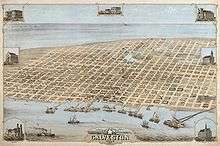
At the end of the 19th century, the city of Galveston was a booming metropolis with a population of 37,000. Its position on the natural harbor of Galveston Bay along the Gulf of Mexico made it the center of trade in Texas, and one of the largest cotton ports in the nation, in competition with New Orleans.[21] Between 1838 and 1842, 18 newspapers were started to serve the island's rapidly growing population (The Galveston County Daily News is the sole survivor).[22] A causeway linking the island with the mainland was finished in 1860, which paved the way for railroad expansion.[23]
During this golden era of Galveston's history, the city was home to a number of state firsts that include: the first post office (1836), the first naval base (1836), the first Texas chapter of a Masonic order (1840), the first cotton compress (1842), the first parochial school (Ursuline Academy) (1847), the first insurance company (1854), the first gas lights (1856), first Roman Catholic hospital (St. Mary's Hospital) (1866),[24] first Jewish Reform Congregation (Congregation B'nai Israel) (1868), the first opera house (1870), the first orphanage (1876), the first telephone (1878), the first electric lights (1883), the first medical college (now the University of Texas Medical Branch) (1891), and the first school for nurses (1890).[12][25]
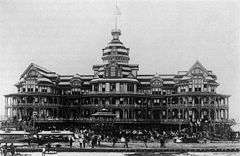
Galveston was also home to the first Roman Catholic cathedral in Texas. In 1839, Rome created the prefecture apostolic of Texas, which was later elevated to a vicariate apostolic on July 10, 1841. Then, on May 4, 1847 Pope Pius IX approved the creation of the Diocese of Galveston and named St. Mary's Church the cathedral for the entire state of Texas.[26]
During the mid 19th century, Galveston, though not a large city by world standards, emerged as an international city with immigration and trade from around the U.S. and around the world. The island has sometimes been called the "Ellis Island of the West" as it was the primary point of entry for European immigrants settling in the western United States.[27] German immigration during this period was so great that the German language became a commonly used language on the city's streets.[28] The immigrants were not simply the poor or the oppressed seeking refuge but many of the educated, middle class. The Galveston Weekly News described one 1849 ship's arrival as carrying members of the "wealthy class" including lawyers and merchants and many skilled workers.
The later 19th century was a high point in the history of civil rights for African Americans. Reconstruction for a time limited the power of former slaveholders in Texas. Leaders, such as George T. Ruby and Norris Wright Cuney, worked to establish educational and employment opportunities for blacks and organize black voters to support the Republican Party, then the main party supporting black rights in the South. Cuney's efforts led to higher employment and higher wages for blacks in the city, especially on the wharves, and eventually led to combined black and white trade unions during the 1890s and early 1900s.[29] Cuney himself rose to the chairmanship of the Texas Republican Party, the most powerful position held by any black American in the 19th century.
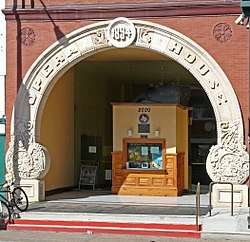
Storm of 1900
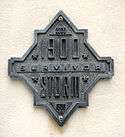
In 1900, the island was struck by a devastating hurricane.[30] Even post-Hurricane Katrina, this event holds the record as the United States' deadliest natural disaster.[30][31] In the early morning of September 8, high surf, despite prevailing winds out of the north, heralded the oncoming storm. By noon, low-lying areas near the Gulf and the Bay side of the city were flooding and the winds increased. Near 4 p.m. a storm surge approximately 15 feet (5 m) high slammed into the coast. Wind speeds reached approximately 125 miles per hour (201 km/h) (an estimate, since the anemometer was blown off the U.S. Weather Bureau building).[30] Isaac Cline was the bureau's chief meteorologist. An account of the events surrounding the hurricane, based on his personal records, is given in Isaac's Storm by Erik Larson. The city was devastated, and an estimated 6,000 to 12,000 people on the island were killed.[30] After the storm, the city decided to shore up its defenses against future storms by constructing a permanent concrete seawall along a large portion of the beach front (1902–1904). The entire grade of the city was raised some 17 feet (5 m) behind the wall to several feet near the Bay (1904–1910).[32]
Rebuilding and the "Open era"
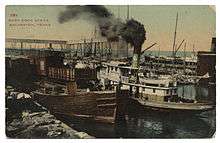
Despite attempts to draw new investment to the city after the hurricane, Galveston has never fully returned to its previous levels of national importance or prosperity. Development was also hindered by the construction of the Houston Ship Channel, which brought the Port of Houston into direct competition with the natural harbor of the Port of Galveston for sea traffic. To further her recovery, and rebuild her population, Galveston actively solicited immigration. Through the efforts of Rabbi Henry Cohen and Congregation B'nai Israel, Galveston became the focus of an immigration plan called the Galveston Movement that, between 1907 and 1914, diverted roughly 10,000 Eastern European, Jewish immigrants from the crowded cities of the Northeastern United States.[33] Additionally numerous other immigrant groups, including Greeks, Italians and Russian Jews came to the city during this period.[34] This immigration trend substantially altered the ethnic makeup of the island, as well as many other areas of Texas and the western U.S.
Though the storm stalled economic development and the city of Houston grew into the region's principal metropolis, Galveston regained some of its former glory. Recognizing the need for Galveston to diversify from the traditional port-related industries, in 1905, William Lewis Moody, Jr., a member of one of Galveston's leading families, founded the American National Insurance Company. Two years later, Mr. Moody would further invest in Galveston by establishing the City National Bank, which would later become the Moody National Bank.[35][36]
A military facility by the US Army Coastal Artillery on Galveston Island was established in the late 1890s and construction, which was disrupted by the Galveston Hurricane of 1900, was completed in the early 1900s, with the facility being named Fort Crockett in 1903. During the First World War, Fort Crockett served as a US Army artillery training center. Troops bound for France were trained in the use of several types of artillery. During the 1920s and early 1930s, Fort Crockett housed the United States Army Air Corps' (USAAC) 3rd Attack Group (an ancestor to USAF's 3rd Wing). At this time, the 3rd Attack Group was the only USAAC group devoted solely to attack aircraft. During the Second World War, focus was placed on defense against German U-boats, and the fort also served as a prisoner of war camp. Following the war, Fort Crockett served for several years as an army recreational center.[37]
The Galveston–Houston Electric Railway was established in 1911 and ran between the city and Houston. The railway was recognized as the fastest interurban line in 1925 and 1926.[38]

During the 1920s and 1930s, the city re-emerged as a major tourist destination.[39][40] Under the influence of Sam Maceo, Rosario Maceo, and Oscar "Dutch" Voigt, the city exploited the prohibition of liquor and gambling in clubs like the Balinese Room, offering entertainment to wealthy Houstonians and other out-of-towners. Combined with prostitution, which had existed in the city since the American Civil War, Galveston became known as the sin city of the Gulf.[41] Galvestonians accepted and even supported the illegal activities, often referring to their island as the "Free State of Galveston."[42][43] The island had entered what would later become known as the open era.[44] Aside from the vice-oriented entertainment the city hosted many legitimate entertainment venues and events. One of the most famous was the annual "Pageant of Pulchritude" beauty contest.[45][46][47] This event became the first international contest and attracted participants from England, Russia, Turkey, Brazil, and many other nations until its demise in 1932.[46]
The 1930s and 1940s brought much change to the Island City. KLUF radio began broadcasting in 1937.[48] During the World War II, the Galveston Municipal Airport, predecessor to Scholes International Airport, was redesignated a U.S. Army Air Corps base and named "Galveston Army Air Field". The United States Army Corps of Engineers, using funds made available by Congress through the Civil Aeronautics Authority, constructed three 6,000-foot (1,800 m) long, hard-surface runways at the airport to accommodate army aircraft.[49] In January 1943, Galveston Army Air Field was officially activated with the 46th Bombardment Group serving an anti-submarine role in the Gulf of Mexico. Later it was replaced by the 10th anti-submarine squadron, flying RM-37 Lockheed Venturas.[50]
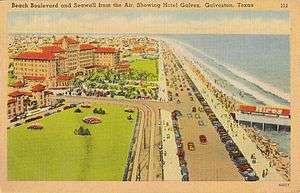
In 1942, William Lewis Moody, Jr., along with his wife Libbie Shearn Rice Moody, established the Moody Foundation, with the purpose of benefiting present and future generations of Texans." The foundation, one of the largest in the United States, would play a prominent role in Galveston during later decades, helping to fund numerous civic and health-oriented programs.[51]
The end of the war drastically reduced military investment in the island. Increasing enforcement of gambling laws and the growth of Las Vegas put pressure on the gaming industry on the island.[52] Finally, in 1957, Texas Attorney General Will Wilson and the Texas Rangers began a massive campaign of raids which wrecked gambling and prostitution in the city.[53][54][55][56] As these vice industries crashed, so did tourism taking the rest of the Galveston economy with it.[57] Neither the economy nor the culture of the city was the same afterward.[58] Civic leaders made several failed attempts at new ventures including the failed Oleander Bowl football tournament and the Pelican Island Bridge for access to a new industrial park which never materialized.[58] Nevertheless, key non-entertainment sectors such as insurance, banking, and the medical school helped to keep the economy viable.
Recent history
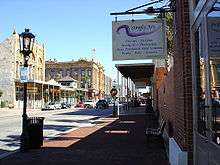
The economy of the island entered a long, stagnant period. Many businesses relocated off of the island. By 1959, the city of Houston had long out-paced Galveston in population and economic growth. Recognizing this, the Reverend Wendelin J. Nold, fifth bishop of the Galveston Diocese, was permitted by the Vatican to erect a Cathedral of convenience in Houston, naming Sacred Heart Church as co-cathedral. The diocese was then re-designated the Diocese of Galveston-Houston. Galveston and St. Mary's Cathedral Basilica still remained the home of the diocese, but now the bishop could more easily access the rapidly growing Roman Catholic population in Houston.[59][60]
Beginning in 1957, the Galveston Historical Foundation began its efforts to preserve historic buildings.[61] The 1966 book The Galveston That Was helped encourage the preservation movement. Restoration efforts financed by motivated investors, notably Houston businessman George P. Mitchell, gradually created the Strand Historic District and reinvented other areas. A new, family-oriented tourism emerged in the city over many years.
In September 1961, an F4 tornado generated by landfalling Hurricane Carla hit the city, killing eight and injuring 200.
The 1960s saw the expansion of higher education in Galveston. Already home to the University of Texas Medical Branch, the city got a boost in 1962 with the creation of the Texas Maritime Academy, predecessor of Texas A&M University at Galveston; and by 1967 a community college, Galveston College, had been formed to help provide affordable education to the community.[62][63]
In the 2000s, property values rose after expensive projects were completed[64] and demand for second homes increased.[65] This led some middle class families to move from Galveston to other areas such as League City, Texas City, and La Marque. The city population remained relatively the same from 2000 to 2005 according to the U.S. Census Bureau.[66] In 2007 The Associated Press compiled a list of the most vulnerable places to hurricanes in the U.S. and Galveston was one of five areas named. Among the reasons cited were low elevation and the single evacuation route off the island which is blocked by the fourth largest city in the United States, Houston.[67]
Hurricane Ike made landfall on Galveston Island in the early morning of September 13, 2008 as a Category 2 hurricane with winds of 110 miles per hour (180 km/h) [68] Ike produced waves and a rising storm surge of about 14 feet (4.3 m), which went around the famous Galveston Seawall, flooding the city via the storm sewers, and the unprotected "bay side" of the island, before the first winds or drop of rain.[69][70] The storm left Galveston without electricity, gas, water pressure and basic communications. The Balinese Room, an historic nightclub, formerly a notorious illegal gambling hall, which was located on a 600-foot (200 m) pier extending into the Gulf of Mexico was destroyed in the storm.[71] The island has since re-established services and the population has returned but some damage remains. Discussions are currently under way to build a so-called Ike Dike which would protect Galveston and the bay.[72] As of 2009 the project is still in the conceptual stage and no funding has been allocated.
The project was still under discussion in 2017 although the Sierra Club and other environmentalists were warning about the risk to marine life in the area. Several groups were providing their own recommendations on the technical aspects and design of the storm-surge protection system.[73][74]
Notes
- "Galveston Island". Handbook of Texas Online. Retrieved 2009-10-03.
- Donald E. Chipman (2008-01-18). "The Handbook of Texas Online, Texas State Historical Association". www.tshaonline.org. pp. article "MALHADO ISLAND". Retrieved 2008-09-30.
- David G. McComb (1986). Table of Contents and Excerpt, McComb, Galveston. Galveston, A History – University of Texas Press. ISBN 978-0-292-72053-4. Retrieved 2009-10-03.
- Barker, Eugene C.; Duncalf, Frederick; Dunn, W. E.; Gutsch, Milton R.; Manning, William R.; Marsh, Frank Burr; Ramsdell, Chas. W.; Riker, Thad W.; Cunningham, C. H., eds. (1918). "The History of Galveston 1518–1900". The Texas History Teachers' Bulletin. 7–14. Austin, TX: University of Texas. pp. 53–54.
- Manso Porto, Carmen (1997). Cartografía histórica de América: catálogo de manuscritos (siglos XVIII-XIX). Madrid, Spain: Real Academia de la Historia. pp. 122–124. ISBN 84-89512-02-7.
- Harris Gaylord Warren. "Aury, Louis Michel". Handbook of Texas Online, Texas State Historical Association. Retrieved 2009-10-03.
- Harris Gaylord Warren. "Lafitte, Jean". Handbook of Texas Online, Texas State Historical Association. Retrieved 2009-10-03.
- Jimmie Walker. "The Legend of Jean Lafitte". Kemah Historical Society. Retrieved 2009-10-03.
- "Port of Galveston". World Port Source. Retrieved 2009-10-03.
- "Menard, Michel Branamour". Handbook of Texas Online, Texas State Historical Association. Retrieved 2009-10-04.
- "The Galveston Collection". Texas Archival Resources Online, University of Houston. Archived from the original on 2008-05-01. Retrieved 2009-10-04.
- "History of Galveston". Isaac's Storm, Random House. Retrieved 2009-10-03.
- "Lindsey, William F." Handbook of Texas Online. Retrieved 2016-03-30.
- "Galveston Island". Handbook of Texas Online, Texas State Historical Association. Retrieved 2009-10-03.
- Cotham (1998), p. 2–3.
- Alwyn Barr. "Galveston, Battle of". Handbook of Texas Online, Texas State Historical Association. Retrieved 2009-10-03.
- "Galveston Weekly News, April 26, 1865". Institute of Nautical Archaeology, Texas A&M University. Retrieved 2009-10-03.
- "Galveston Laboratory Home". National Oceanic and Atmospheric Administration. Retrieved 2013-02-28.
- Teresa Palomo Acosta. "Juneteenth". Handbook of Texas Online, Texas State Historical Association. Retrieved 2009-10-03.
- "African American Heritage". Galveston Historical Foundation. Archived from the original on 2009-08-13. Retrieved 2009-09-26.
- Edward Coyle Sealy. "Galveston Wharves". Handbook of Texas Online, Texas State Historical Association. Retrieved 2009-09-13.
- "The History of Galveston". Wyndham Hotels. Retrieved 2009-09-26.
- "Galveston Causeway". AllBusiness.com. Retrieved 2009-09-13.
- "The CHRISTUS legacy Answering the call". Christus Health. Archived from the original on October 18, 2007. Retrieved 2009-10-03.
- "History: Galveston's Colorful Past". Galveston Chamber of Commerce. Archived from the original on 2011-06-08. Retrieved 2009-10-03.
"The History of Galveston". Wyndham Hotels. Retrieved 2009-10-03.
Barrington, Carol; Kearney, Sydney (2006). Day Trips from Houston: Getaway Ideas for the Local Traveler. Globe Pequot. p. 241. ISBN 0-7627-3867-7. - "The History of The Mother Church of Texas". St. Mary Cathedral Basilica. Archived from the original on 2010-11-24. Retrieved 2009-10-03.
Tara Dooley (2008-03-30). "The Archdiocese of Galveston-Houston began in a wood-frame church during the Republic of Texas". Houston Chronicle. Retrieved 2009-10-03.
Tara Dooley (2003-01-04). "At 155, Galveston's St. Mary's still battles the storms". Houston Chronicle. Retrieved 2009-10-03. - "Gateway on the Gulf: Galveston and American Immigration, 1845–1915". Humanities Texas (Teacher Institutes). Archived from the original on July 21, 2009. Retrieved 2009-10-03.
- Hardwick (2002), pg. 28–29
- Obadele-Starks, Ernest (2001). Black Unionism in the Industrial South. Texas A&M University Press. pp. 39–44. ISBN 0-89096-912-4.
- John Edward Weems. "Galveston Hurricane of 1900". Handbook of Texas Online, Texas State Historical Association. Retrieved 2009-10-04.
- Joe Strupp (4 September 2000). "Nation's deadliest natural disaster". Editor & Publisher. Retrieved 4 January 2017.
- "Galveston and Texas History Center". Rosenberg Library, Galveston. Archived from the original on 2009-03-21. Retrieved 2009-10-03.
- "Galveston Movement". Handbook of Texas Online, Texas State Historical Association. Retrieved 2009-10-03.
- Hardwick (2002), pg.13
- "Annual Financials report, 2004–2005" (PDF). The Moody Foundation. Archived from the original (PDF) on 2009-05-29. Retrieved 2009-10-03.
- "American National Announces Fourth Quarter 2007 Results" (PDF). American National Insurance Company. Archived from the original (PDF) on October 1, 2011. Retrieved 2009-10-03.
- Darst, Maury. "Fort Crockett". Handbook of Texas Online, Texas State Historial Association. Retrieved 4 January 2017.
- Rieder, Robert A. "Electric Interurban Railways". Handbook of Texas Online, Texas State Historical Association. Retrieved 26 September 2009.
- "Galveston Hotel – Hotel Galvez to Reopen October 15". Bloomberg.com. Retrieved 2009-09-26.
- "Preserve America Community: Galveston, Texas". Retrieved 2009-09-26.
- David G. McComb. "Galveston, TX". Handbook of Texas Online, Texas State Historical Association. Retrieved 2009-09-26.
- John Nova Lomax (2009-03-03). "Is Casino Gambling in the Cards for Galveston?". Houston Press. Retrieved 2009-09-26.
- "The Press: Gambling in Texas". Time Magazine. 1952-01-12. Retrieved 2009-09-26.
- Melosi, Martin V.; Pratt, Joseph A. (2007). Energy metropolis: an environmental history of Houston and the Gulf Coast. University of Pittsburgh Press. ISBN 978-0-8229-4335-8.
-
- Stein, Elissa (2006). Beauty Queen: Here She Comes.... Chronicle Books. p. 37. ISBN 0-8118-4864-7.
- "Miss United States Began In Galveston". The Islander Magazine. 2006.
- Cherry, Bill (25 October 2004). "Miss America was once Pageant of Pulchritude". Galveston Daily News. Archived from the original on 21 October 2009.
- Jack Alicoate, ed. (1939), "Standard Broadcasting Stations of the United States: Texas", Radio Annual, New York: Radio Daily, OCLC 2459636
- Maury Darst. "Galveston Army Airfield". Handbook of Texas Online, Texas State Historical Association. Retrieved 2009-06-23.
- "46th Bombardment Group, WWII, World War II, Army Air Forces". Army Air Corps Library and Museum. Archived from the original on 2011-07-25. Retrieved 2009-06-23.
- Robert E. Baker. "Moody Foundation". Handbook of Texas Online, Texas State Historical Association. Retrieved 2009-10-03.
- Utley Robert Marshall (2007). Lone Star Lawmen. Oxford. p. 218. ISBN 9780198035169.
- James G. Dickson, Jr. "Attorney General". Handbook of Texas Online, Texas State Historical Association. Retrieved 2009-09-26.
- "The Daily News: Headlines". The Galveston County Daily News. Archived from the original on 2010-02-08. Retrieved 2009-09-26.
- Sitton, Thad (2006). The Texas Sheriff: Lord of the County Line. University of Oklahoma Press. p. 146. ISBN 978-0-8061-3471-0.
- "Grande Dame of the Gulf". Texas Monthly: 169. December 1983.
- Melosi, Martin V.; Pratt, Joseph A. (2007). Energy metropolis: an environmental history of Houston and the Gulf Coast. University of Pittsburgh Press. p. 202. ISBN 978-0-8229-4335-8.
- Paul Burka (1983-12-01). "Grande Dame of the Gulf". Texas Monthly. Retrieved 2009-09-27.
- Julia Dunn (1989-11-04). "Bishops celebrate 200th birthday". Houston Chronicle. Retrieved 2009-10-03.
- Richard Vara (2008-03-30). "The cradle of Texas' Catholicism, The state's first cathedral in need of major repair". Houston Chronicle. Retrieved 2009-10-03.
- Melosi, Martin V.; Pratt, Joseph A. (2007). Energy metropolis: an environmental history of Houston and the Gulf Coast. University of Pittsburgh Press. p. 202. ISBN 978-0-8229-4335-8.
- "The History of Galveston College". Galveston College. Archived from the original on 2009-09-21. Retrieved 2009-10-04.
- Rhiannon Myers (2007-11-14). "Students brave the simulated seas". The Galveston County Daily News. Archived from the original on 2011-09-28. Retrieved 2009-09-13.
- Novak, Shonda. "Growth Wave Hits Galveston." Austin American-Statesman. Saturday July 22, 2006.
- Harvey Rice (2007-02-22). "Workers in Galveston increasingly can't afford to live there". Houston Chronicle. Retrieved 2009-10-04.
- Marty Schladen (2006-07-23). "Forces drive people off island". The Galveston County Daily News. Archived from the original on 2011-09-28. Retrieved 2009-10-04.
- "Where's the next New Orleans?: Galveston, New York City, Miami among top 5 places most vulnerable to a powerful hurricane this season, AP finds". Decatur Daily (Associated Press). 2007-06-01. Archived from the original on 2007-06-06. Retrieved 2009-10-04.
- "Ike Insured Damage Estimates Range from $6B to $18B". Texas / South Central News, Insurance Journal. 2008-09-15. Retrieved 2009-10-03.
- Mike Carney; Oren Dorell (2008-09-12). "Hurricane Ike: Galveston says 25% ignored evacuation order". USA TODAY. Archived from the original on September 15, 2008. Retrieved 2008-09-12.
- Ben Casselman (2008-09-12). "As Waters Rise, Many Decline To Leave Galveston Island". The Wall Street Journal. Retrieved 2008-09-13.
- "Historic Balinese Room Nightclub & Live Music". Balinese Room. Retrieved 2009-10-04.
- Ben Caselman (2009-06-04). "Planning the 'Ike Dike' Defense, Houston-Area Leaders Envision a 60-Mile Barrier Against Hurricane Flooding". Wall Street Journal. Retrieved 2009-10-04.
- "Environmentalists skeptical of Ike Dike". houstonchronicle.com. Retrieved 22 April 2018.
- news, ted oberg, oberg investigates, investigative reporter, eyewitness (20 June 2017). "9 years after storm, 'Ike Dike' still under discussion". abc13.com. Retrieved 22 April 2018.
References
- Cotham, Edward Terrel (1998). Battle on the Bay: the Civil War struggle for Galveston. Austin, TX: University of Texas Press. ISBN 978-0-292-71205-8.
- Hardwick, Susan Wiley (2002). Mythic Galveston: reinventing America's third coast. JHU Press. p. 13. ISBN 0-8018-6887-4.
Further reading
- "Galveston". Texas State Gazetteer and Business Directory. St. Louis: R.L. Polk & Co. 1884.
- George E. Waring, Jr.; U.S. Department of the Interior, Census Office (1887), "Texas: Galveston", Report on the Social Statistics of Cities: Southern and the Western States, Washington DC: Government Printing Office, pp. 315–322
- "Galveston". Texas State Gazetteer and Business Directory. Detroit: R.L. Polk & Co. 1890.
- Directory of the City of Galveston. 1906.
- Ellis A. Davis; Edwin H. Grobe (eds.). "(Galveston)". New Encyclopedia of Texas. Dallas: Texas Development Bureau – via Internet Archive. circa 1926?

- Federal Writers' Project (1940), "Galveston", Texas: A Guide to the Lone Star State, American Guide Series, New York: Hastings House – via HathiTrust
- Paul T. Hellmann (2006). "Texas: Galveston". Historical Gazetteer of the United States. Taylor & Francis. ISBN 1-135-94859-3.
External links
- The early history of Galveston, by Dr. J. O. Dyer, published 1916, hosted by the Portal to Texas History
- History of Galveston
- Bio of Isaac Monroe Cline
- "Historical Maps of Texas Cities: Galveston". Perry–Castañeda Library Map Collection. University of Texas at Austin.
- Items related to Galveston, Texas, various dates (via Digital Public Library of America)